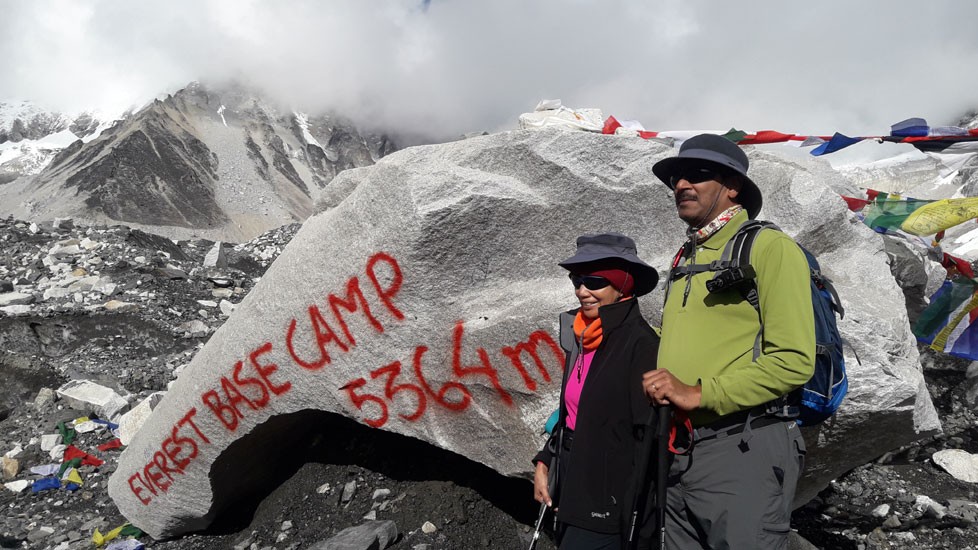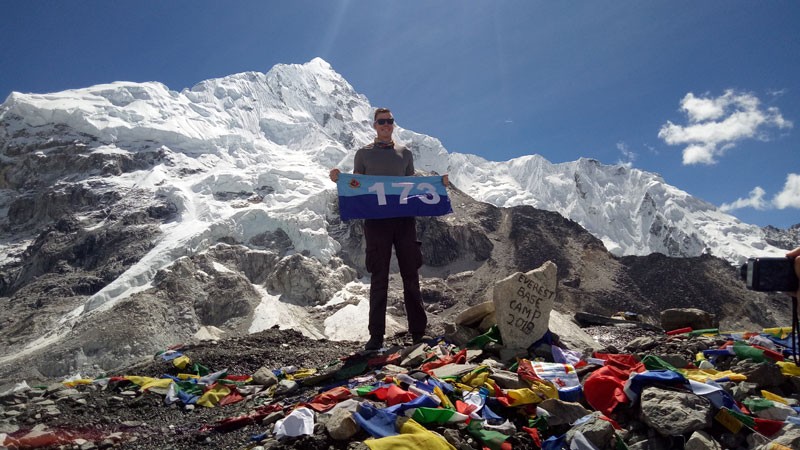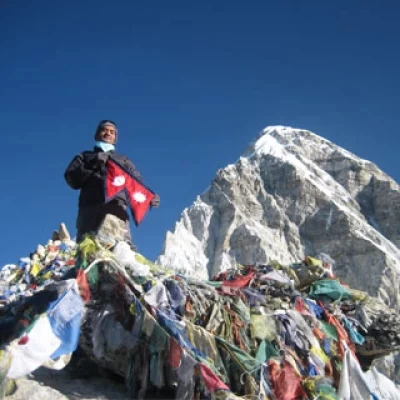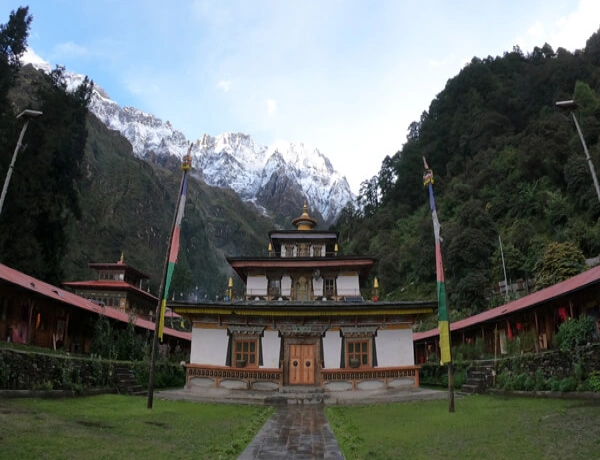How High is Everest Base Camp?
You will find altitude at Everest Base Camp (5,360 m/17,585 f) and somewhere else (5,380 m/17,651 f) and maybe find it different than this. The most popular Trek maps indicate Mount Everest Base Camp's elevation as 5,364 meters. In conclusion, the lowest EBC height is 5,360 meters and 5,560 meters is the highestelevation of Mt. Everest Base Camp.
Everest Base Camp Elevation Highlights
| Elevation (feet) |
17,585F |
| Elevation (meters) |
5,360M | 17,585F |
| Nearest Airport |
Lukla |
| Continent |
Asia |
| Country |
Nepal |
| Range/Region |
Khumbu Himalaya Range in Central Region |
| Latitude |
28.007267 |
| Longitude |
86.858122 |
| Difficulty |
Moderate to Strenuous |
| Walking Time |
2 Hours |
| Hiking From |
Gorakshep (The last Tea House for Everest Base Camp Trek) |
| Best Season |
Sep, Oct, Nov, Mar, Apr, May |

Everest Base Camp Trek Elevation Profile:
Everest Base Camp is the main attraction for trekkers to see the amazing glacier, Khumbu Icefall, and the astonishing scenery of snowcapped mountains around you. The Everest Base Camp Hike starts at Lukla, an elevation of 2,840 meters from sea level, after a scenic flight from Kathmandu. Then gaining height every footstep higher and higher to the historic trading point Namche Bazaar (3,440 meters), the Buddhist sacred place Tengboche (3,860 meters), Dingboche (4,410 meters), Lobuche (4,910 meters), Gorak Shep (5,140 meters) and finally getting in your dream destination, Mt. Everest Base Camp. As the Elevation of Everest Base Camp is very high, you need to be well prepared to face any circumstances that may arise while at base camp. It is advised that you wear warm clothes and have enough drinking water while visiting the Everest Base camp.
Here is the Everest Base Camp Elevation Profile:
| S.N. |
Places |
Elevation |
| 01 |
Kathmandu |
1,300m |
| 02 |
Lukla |
2,800m |
| 03 |
Phakding |
2,640m |
| 04 |
Namche Bazaar |
3,430m |
| 05 |
Khumjung Village |
3,790m |
| 06 |
Tengboche |
3,867m |
| 07 |
Dingboche |
4,410m |
| 08 |
Dingboche/Nangkat Tshang Peak |
4,330m/5,615m |
| 09 |
Lobuche |
4,930m |
| 10 |
Gorak Shep / EBC |
5,140m/5,360m |
| 11 |
Kalapatthar/ Pheriche |
5,555m/4,240m |
| 12 |
Tengboche |
3,867m |
| 13 |
Namche Bazaar |
3,430m |
| 14 |
Phakding |
2,640m |
| 15 |
Lukla |
2,800m |
| 16 |
Kathmandu |
1,350m |
To get to Everest Base Camp Elevation, do we need training and physical fitness?
The elevation of the EBC trek begins from 2,680 meters at Tenzing Hillary Airport and ascends to a maximum elevation of 5,643 meters at Kala Patthar. You will travel above 2,500 meters of elevation during the entire trip. Due to this, you are required to be physically fit to at least a certain extent to complete the trek.
In terms of training for Everest Base Camp Elevation, there aren't many technical aspects to it. However, you must be aware of the elevation of the EBC Trek, the risks, and their controlling measures for a safe and enjoyable trip.
The essential thing to do is to start doing cardiovascular exercises to increase your stamina. You will be covering great distances during the trek. Thus, to avoid getting tired and feeling pain in your legs, cardiovascular exercises can be of great help. Next, you can also practice strengthening exercises. While exercising for strength, make sure to focus on your legs primarily. Some examples of strength exercises are squats, lunges, pushups, sit-ups, etc.
For training, as mentioned above, you do not need technical skills for this trek. However, you should have thorough knowledge about the elevation of the EBC trek and altitude sickness. This is the only training you will need for the Everest Base Camp Trek.
Where is Everest Base Camp located?
Mt. Everest is located in the Everest (Khumbu) region in the northeastern region of Nepal. When someone refers to EBC, there are two locations: South Base Camp and North Base Camp. The South Base Camp lies on the Nepalese side, whereas the North Base Camp lies on the Tibetan Chinese side. The South Base Camp on the Nepalese side is located at an altitude of 5,364 meters (17,598 feet). The geographical coordinates of the location are 28°0′26″N 86°51′34″E.
Everest Base Camp Trek Video:
Can we see the view of Everest from the Base Camp?
No! Unfortunately, you cannot see a clear view of Everest from Everest Base Camp. Many tall mountains block your view of Everest. However, during the journey from Lukla, you get marvelous views of Everest as you are walking towards it. Even further from the base camp, you will be reaching Kala Patthar, the best place to view Everest. After observing the environment surrounding the Everest Base Camp, which is amazing and close to the Khumbu Glacier, you won't regret walking there. Mountains are in every direction. Likewise, Khumbu Icefall and Glacier Marine.
Reaching the base camp gives you a feeling of victory standing atop the foot of the world’s tallest mountain. Whereas reaching Kala Patthar gives you outstanding views of Everest and neighboring peaks such as Lhotse, Nuptse, Ama Dablam, Cho Oyu, etc.
Mount Everest Base Camp Trek: Essential Tips and Information for Your Successful Trip on the Base of the World “Mt. Everest 8,848.86m”
Here is a list of some tips that will help make your trip successful. Kindly go through it.
- Experience the Ultimate Everest Base Camp Helicopter Tour:A Comprehensive Guide
- Daily Bus and Jeep Service from Kathmandu to Lukla: Private and Shared Options Available
- 7 Money-Saving Tips to EnhanceYour Everest Base Camp Trek Experience
- Experience the Adventure of a Lifetime: The Ultimate Guide to Everest Base Camp Trek in 2023-2024
- 14-Day Everest Base Camp Trek Itinerary: A Step-by-Step Guide for a Memorable Journey
- Unlocking the Secrets of Everest Base Camp Trek: Top 7 Insider Tips You Need to Know
- 30 Mind-Blowing Facts About Mount Everest: Discovering the World's Tallest Mountain
- 15 Essential Tipsfor a Safe and Enjoyable Trek to Mount Everest Base Camp
- Lukla Airport: Your Gateway to the Top of the World Adventure
- Where is Mount Everest Located? Exploring the Geographic Wonder of the World
- The Best Time to Trek to Everest Base Camp: A Guide to Choosing the Perfect Season
- How Much Does an Everest Base Camp Trek Cost? A Breakdown of Expenses and Savings Tips
- Getting to Everest Base Camp: A Comprehensive Guide to Transportation and Routes
- Your Ultimate Everest Base Camp Trek Packing List: Essentials and Recommendations
- Kalapatthar: Experience the Best Views of Mount Everest on Your Trek
- Understanding Flights from Kathmandu to Lukla: Why Departure from Ramechhap is Recommended
How can we get to Mt. Everest Base Camp?
The most popular way to get to EBC is by trekking. But first, to get to EBC, you will need to reach the Khumbu region. The easiest way to reach here is via a flight to Lukla airport. There are also other alternatives, but there is no other direct way to get here. For road travel, you can drive to Phaplu and then trek to Lukla.
From Lukla, you can follow the standard route of the EBC trek, which is: Phakding, Namche Bazaar, Tengboche, Dingboche, Lobuche, Gorak Shep, and EBC. If you do not have the time to reach here by trekking, you can also opt for a helicopter flight. The EBC helicopter flight will take you directly to Kala Patthar.
Similarly, there is road access near Lukla. So, the jeep can drive to Thamdanda, from where it takes a 4 to 5-hour walk to get to Lukla. If you are looking to escape the Lukla flight, then driving Kathmandu to Lukla by Jeep is the best option.

The most popular trek in the Everest Region
- Everest Base Camp Trek -14 Days
- Everest Base Camp Trek and Fly Back Helicopter -9 Days
- Everest 3 Passes Trek -21 Days
- Everest Base Camp Trek -8 Days
- Gokyo Chola Pass Trek -19 Days
Everest Base Camp Trek difficulty due to the elevation of Everest base camp?
The EBC trek is a high-altitude trek. The difficulty of this trek is moderately strenuous. It is suitable for those who have experience in high-altitude trekking. One of the major reasons for the demanding nature of the trek is the altitude. The course of the EBC trek lies in a range of 2,680 meters to 5,545 meters.
Walking long distances during the trek itself is a challenge. However, high altitude also invites various risks. One particular risk is altitude sickness. It is generally perceived that altitude sickness is more likely to happen above 2,500 meters. The EBC trek follows a route above this mark. Therefore, the difficulty level of the journey is elevated due to this risk. Also, you will be walking uphill for the majority of the journey to ascend the altitude. Walking uphill can be strenuous for the legs and tiring.
Everest Base Camp Elevation with Trekking Itinerary
The standard Everest Base Camp trek alone is a 14-day journey. The itinerary of the EBC trek along with the elevation of different places, is as follows:
Day 1: Arrival at Kathmandu, trekking preparation and Permit work.
Day 2: Fly to Lukla (2,680 m) and trek to Phakding (2,700 m)
Day 3: Phakding to Namche Bazaar (3,400 m)
Day 4: Acclimatization day, hike to Everest View Hotel (optional) (3,962 m)
Day 5: Namche to Tengboche (3,860 m)
Day 6: Tengboche to Dingboche (4,410 m)
Day 7: Acclimatization Day hike to climb to Nangkartshang Peak (5,615 m): 2 Hours.
Day 8: Dingboche to Lobuche (4,910 m)
Day 9: Lobuche to Gorak Shep (5,180 m), hike to Everest Base Camp (5,364 m), and night at Gorak Shep
Day 10: Gorak Shep to Kala Patthar (5,545 m) and back to Pheriche (4,210 m)
Day 11: Pheriche to Namche (3,440 m)
Day 12: Namche to Lukla (2,680 m)
Day 13: Flight to Kathmandu
Day 14: Final departure for home destination.
Everest Base Camp Elevation Map Chart
The EBC trek has varying levels. However, the altitude ascends until Kala Patthar and descends after that. Everest Base Camp Trek 1 Day begins at 2,680m and maps towards 2,700m, 3,440m, 3,962m, 3,860m, 4,410m, 4,910m, 5,180m, 5,364m, and 5,545m. From here, it descends towards 4,210 m, 3,440 m, and 2,680 m.

Everest Base Camp Elevation in Meters and feet
Everest Base Camp Elevation in meters is 5,364 meters, and in feet is 17,594 feet above sea level. Everest Base Camp is the second-highest point of the trek after Kala Patthar.
Everest Base Camp Elevation Gain
The EBC trek begins from 2,680 meters or 8,792 feet at Lukla and reaches its maximum point at 5,545 meters or 11,283 feet at Kala Patthar. The total altitude gain is about 2,865 during the entire trip. The average elevation gain during ascending is about 600 meters.
Everest Base Camp Trek: Altitude Sickness
One of the significant safety issues of the EBC trek is altitude sickness. Altitude sickness due to high elevation is a common issue that can be avoided. Altitude sickness is a sickness when the body is not able to adapt to the change in oxygen levels as the altitude increases. The atmosphere of high-altitude regions has a meager oxygen quantity. Thus, while ascending, there is less oxygen for the body to take in.
If you do not follow proper trekking techniques, you might get altitude sickness. Some common symptoms of altitude sickness are nausea or headache, vomiting, loss of appetite, sleeplessness, confusion, disorientation, weakness, swelling of hands and face, and shortness of breath with breathing irregularity. If you experience any of these symptoms, you should immediately inform your partners and seek medical attention.
Altitude sickness has no immediate cure. Thus, descending is the only way to survive. Medicines such as Diamox can help slow down effects, but the results are only temporary. It is better to avoid altitude sickness than to seek its cure. There are various ways you can prevent this sickness.
First, it is crucial that you maintain a good pace that your body can handle. Do not rush while ascending and let the body adapt to the altitude. Taking acclimatization days is very important, as these breaks give your body more time to adjust to the oxygen levels. Staying hydrated, getting enough sleep, consuming enough nutrients, and avoiding alcohol and tobacco are also a few ways to prevent altitude sickness.
If you require any further information regarding Everest, please feel free to Contact Nepal Mother House. Or you may drop your own experience below the comments box as well. We are here for your assistance.







